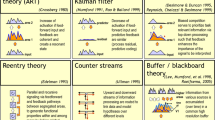Abstract
We describe a neuron multi-layered architecture that extracts landmark points of high curvature from 2d shapes and resembles the visual pathway of primates. We demonstrate how the rotated orientation specific receptive fields of the simple neurons that were discovered by Hubel and Wiesel can perform landmark point detection on the 2d contour of the shape that is projected on the retina of the eye. Detection of landmark points of high curvature is a trivial task with sophisticated machine equipment but we demonstrate how such a task can be accomplished by only using the hardware of the visual cortex of primates abiding to the discoveries of Hubel and Wiesel regarding the rotated arrangements of orientation specific simple neurons. The proposed layered architecture first extracts the 2dimensional shape from the projection on the retina then it rotates the extracted shape in multiple layers in order to detect the landmark points. Since rotating the image about the focal origin is equivalent to the rotation of the simple cells orientation field, our model offers an explanation regarding the mystery of the arrangement of the cortical cells in the areas of layer 2 and 3 on the basis of shape cognition from its landmark points.
Access this chapter
Tax calculation will be finalised at checkout
Purchases are for personal use only
Preview
Unable to display preview. Download preview PDF.
Similar content being viewed by others
References
Asada, H., Brady, M.: The curvature primal sketch. IEEE Trans. Pattern Anal. Mach. Intell. PAMI-8(1), 2–14 (1986)
Attneave, F.: Some informational aspects of visual perception. Psychol. Rev. 61, 183–193 (1954)
Berretti, S., Del Bimbo, A., Pala, P.: Retrieval by Shape Similarity with Perceptual Distance and Effective Indexing. IEEE Trans on Multimedia 2(4), 225–239 (2000)
Biederman, I.: Recognition-by-Components: A Theory of Human Image Understanding. Psychological Review 94, 115–147 (1987)
Bookstein, F.L.: Landmark methods for forms without landmarks: morphometrics of group differences in outline shape. Med. Im. Anal. 1(3), 225–243 (1996)
Brenner, E., Smeets, J.B.J.: Size illusion influences how we lift but not how we grasp an object. Experimental Brain Research 111, 473–476 (1996)
Dudek, G., Tsotsos, J.K.: Shape representation and recognition from multiscale curvature. Comput. Vis. Image Understand 68, 170–189 (1997)
Drigas, S., Koukianakis, G., Papagerasimou, V.: A System For Hybrid Learning And Hybrid Psychology. In: 2nd International Conference on Cybernetics and Information Technologies, Systems and Applications: CITSA 2005, Orlando, Florida (2005)
Fukushima, K., Miyake, S.: Neocognitron: A self-organizing neural network model for a mechanism of visual pattern recognition. In: Amari, S., Arbib, M.A. (eds.) Competition and Cooperation in Neural Nets. Lecture Notes in Biomathematics, vol. 45, pp. 267–285. Springer, Heidelberg (1982)
Goodale, M.A., Meenan, J.P., Buelthoff, H.H., Nicolle, D.A., Murphy, K.J., Racicot, C.I.: Separate neural pathways for the visual analysis of object shape in perception and prehension. Current Biol. 4, 604–610 (1994b)
Goodale, M.A., Milner, A.D., Jakobson, L.S., Carey, D.P.: A neurological dissociation between perceiving objects and grasping them. Nature 349, 154–156 (1991)
Hubel, D.H.: Evolution of ideas on the primary visual cortex. In: 1955-1978: A biased historical account, Nobel lecture Harvard Medical School, Department of Neurobiology, Boston, Massachusetts, U.S.A., Nature, 8 December 1981. vol. 299, pp. 515–524 (1981)
Rock, I.: Brain mechanisms of vision. The Perceptual world, pp. 3–24. W. H. Freeman, NY
Receptive fields and functional architecture of monkey striate cortex. J. Physiol. 195, 215–243
Anatomical demonstration of orientation columns in macaque monkey. J. Comp. Neurol. 177, 361–380
Jalba, A.C., Wilkinson, M.H.F., Roerdink, J.B.T.M.: Shape Representation and Recognition Through Morphological Curvature Scale Spaces. IEEE Trans. Image Proc. 15(2), 331–341 (2006)
Kayaert, G., Biederman, I., Vogels, R.: Shape Tuning in Macaque Inferior Temporal Cortex. The Journal of Neuroscience 23(7), 3016–3027 (2003)
Milner, A.D., Goodale, M.A.: Visual pathways to perception and action. In: Hicks, T.P., Molotchnikoff, S., Ono, T. (eds.) Progress in Brain Research, 95th edn., pp. 317–337. Elsevier, Amsterdam (1993)
Mokhtarian, F., Mackworth, A.K.: Scale-based description and recognition of planar curves and two-dimensional shapes. IEEE Trans. Pattern Anal. Mach. Intell. PAMI-8(1), 34–43 (1986)
A theory of multiscale, curvature-based shape representation for planar curves. IEEE Trans. Pattern Anal. Mach. Intell. 14(6), 789–805 (1992)
Pomerantz, J.R., Sager, L.C., Stoever, R.J.: Perception of wholes and their component parts: Some configural superiority effects. J. Exp. Psychol. 3, 422–435 (1977)
Pavlidis, T.: Algorithms for shape analysis of contours and waveforms. IEEE Trans. Pattern Anal. Mach. Intell. PAMI-2(3), 301–312 (1980)
Shams, S.: Affine Invariant Object Recognition through Self Organi-zation, Hughes Research Laboratories (1997)
Super, B.J.: Fast correspondence-based system for shape-retrieval. Patt. Recog. Lett. 25, 217–225 (2004)
Ungerleider, L.G., Courtney, S.M., Haxby, J.V.: A neural system for human visual working memory. Proc. Natl. Acad. Sci. USA 95, 883–890 (1998)
Wang, Y.-p., Lee, S.L., Toraichi, K.: Multiscale curvature based shape represent-tation using b-spline wavelets. IEEE Trans. Image Process. 8(10), 1586–1592 (1999)
Author information
Authors and Affiliations
Editor information
Editors and Affiliations
Rights and permissions
Copyright information
© 2006 Springer-Verlag Berlin Heidelberg
About this paper
Cite this paper
Raftopoulos, K., Papadakis, N., Ntalianis, K. (2006). Visual Pathways for Detection of Landmark Points. In: Kollias, S.D., Stafylopatis, A., Duch, W., Oja, E. (eds) Artificial Neural Networks – ICANN 2006. ICANN 2006. Lecture Notes in Computer Science, vol 4131. Springer, Berlin, Heidelberg. https://doi.org/10.1007/11840817_76
Download citation
DOI: https://doi.org/10.1007/11840817_76
Publisher Name: Springer, Berlin, Heidelberg
Print ISBN: 978-3-540-38625-4
Online ISBN: 978-3-540-38627-8
eBook Packages: Computer ScienceComputer Science (R0)




